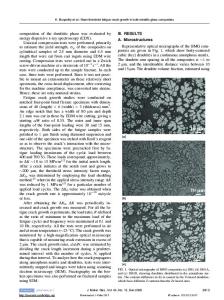Mixed-Mode I and II fatigue threshold and crack closure in dual-phase steels
- PDF / 1,280,677 Bytes
- 11 Pages / 598 x 778 pts Page_size
- 19 Downloads / 342 Views
I,
INTRODUCTION
IN practice, many engineering components and structures are subjected to various combinations of axial, bending, and torsional loading that may involve two or three loading modes, for example, mode I (tensile), mode II (shearing), and mode III (tearing), resulting in two or three modes of crack growth.tl-~4] While a large number of articles have been well developed dealing with the pure mode I case, procedures for mixed-mode loading are less well developed. Only a limited number of investigations have been concerned with mixed-mode fatigue crack growth, especially at the near-threshold region, t9-~4] It is well accepted that the behavior of nearthreshold crack growth is quite different from that in the high Ak region. For example, crack extension per cycle is of the same order of magnitude as microstructural features; both shear crack growth and the early stages of tensile crack growth are of crystallographic natures, and the fatigue crack proceeds along slip planes or grain boundaries, tl~] Such analyses will help ascertain the conditions for both infinite fatigue life and the size of defects that can be tolerated in an engineering situation. Unfortunately, there are not many quantitative studies on the threshold behavior and crack closure under the mixedmode I and II loading. Y.S. ZHENG, formerly Ph.D. Student, State Key Laboratory for Fatigue and Fracture of Materials, Institute of Metal Research, Academia Sinica, Shenyang, 110015, People's Republic of China, is with the State Key Laboratory on High Performance Ceramics and Superfine Microstructure, Shanghai Institute of Ceramics, Chinese Academy of Sciences, Shanghai, 200050, People's Republic of China. Z.G. WANG, Professor and Head, and S.H. AI, Assistant Professor, are with the State Key Laboratory for Fatigue and Fracture of Materials, Institute of Metal Research, Academia Sinica, Shenyang, 110015, People's Republic of China. Manuscript submitted September 22, 1992. METALLURGICALAND MATERIALSTRANSACTIONS A
It is well known that the dual-phase steels (DPS) have the highest ambient-temperature fatigue threshold reported for metallic alloys to date without a sacrifice in strength, t15-2It and the higher threshold values result from the higher crack closure levels caused by a combination of modes I and II at a near-threshold range under the mode I load condition. Such high levels of crack closure in the dual-phase (DP) microstructures were due to the tortuosity of crack path in the softer ferrite (F) and crack deflection at F / F and F/martensite (Ma) interfaces. A fatigue crack is often initiated by a localized cyclic plastic deformation in a crystal where the active slip plane coincides with the plane of maximum shear stress. Once a crack is initiated, the crack will propagate on the maximum shear plane for a while and, in the majority of the cases, will eventually change to the plane of the applied tensile stress. The "shear" and "tensile" modes of fatigue crack propagation are termed stage 1 and stage 2 fatigue crack growth, t421 respectiv
Data Loading...











